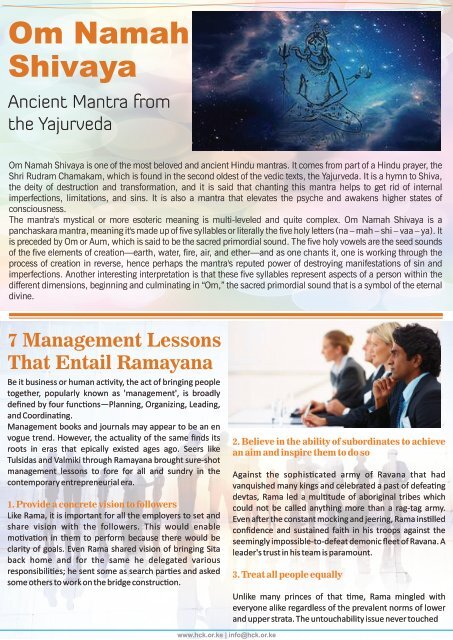Hindu Deep July 2016.compressed (1)
You also want an ePaper? Increase the reach of your titles
YUMPU automatically turns print PDFs into web optimized ePapers that Google loves.
Om Namah<br />
Shivaya<br />
Ancient Mantra from<br />
the Yajurveda<br />
Om Namah Shivaya is one of the most beloved and ancient <strong>Hindu</strong> mantras. It comes from part of a <strong>Hindu</strong> prayer, the<br />
Shri Rudram Chamakam, which is found in the second oldest of the vedic texts, the Yajurveda. It is a hymn to Shiva,<br />
the deity of destruction and transformation, and it is said that chanting this mantra helps to get rid of internal<br />
imperfections, limitations, and sins. It is also a mantra that elevates the psyche and awakens higher states of<br />
consciousness.<br />
The mantra's mystical or more esoteric meaning is multi-leveled and quite complex. Om Namah Shivaya is a<br />
panchaskara mantra, meaning it's made up of ve syllables or literally the ve holy letters (na – mah – shi – vaa – ya). It<br />
is preceded by Om or Aum, which is said to be the sacred primordial sound. The ve holy vowels are the seed sounds<br />
of the ve elements of creation—earth, water, re, air, and ether—and as one chants it, one is working through the<br />
process of creation in reverse, hence perhaps the mantra's reputed power of destroying manifestations of sin and<br />
imperfections. Another interesting interpretation is that these ve syllables represent aspects of a person within the<br />
different dimensions, beginning and culminating in “Om,” the sacred primordial sound that is a symbol of the eternal<br />
divine.<br />
7 Management Lessons<br />
That Entail Ramayana<br />
Be it business or human ac vity, the act of bringing people<br />
together, popularly known as 'management', is broadly<br />
defined by four func ons—Planning, Organizing, Leading,<br />
and Coordina ng.<br />
Management books and journals may appear to be an en<br />
vogue trend. However, the actuality of the same finds its<br />
roots in eras that epically existed ages ago. Seers like<br />
Tulsidas and Valmiki through Ramayana brought sure-shot<br />
management lessons to fore for all and sundry in the<br />
contemporary entrepreneurial era.<br />
1. Provide a concrete vision to followers<br />
Like Rama, it is important for all the employers to set and<br />
share vision with the followers. This would enable<br />
mo va on in them to perform because there would be<br />
clarity of goals. Even Rama shared vision of bringing Sita<br />
back home and for the same he delegated various<br />
responsibili es; he sent some as search par es and asked<br />
some others to work on the bridge construc on.<br />
2. Believe in the ability of subordinates to achieve<br />
an aim and inspire them to do so<br />
Against the sophis cated army of Ravana that had<br />
vanquished many kings and celebrated a past of defea ng<br />
devtas, Rama led a mul tude of aboriginal tribes which<br />
could not be called anything more than a rag-tag army.<br />
Even a er the constant mocking and jeering, Rama ins lled<br />
confidence and sustained faith in his troops against the<br />
seemingly impossible-to-defeat demonic fleet of Ravana. A<br />
leader's trust in his team is paramount.<br />
3. Treat all people equally<br />
Unlike many princes of that me, Rama mingled with<br />
everyone alike regardless of the prevalent norms of lower<br />
and upper strata. The untouchability issue never touched<br />
www.hck.or.ke | info@hck.or.ke







